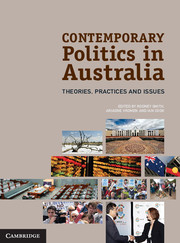Book contents
- Frontmatter
- Contents
- Tables and figures
- Contributors
- Acknowledgements
- Introduction
- I Contemporary Theories of Australian Politics
- Part II Politics in Everyday Australian Life
- Part III Elections
- Part IV Participation and Representation
- Introduction to Part IV
- 15 Participation and representation through political parties
- 16 Pressure groups and lobbying
- 17 Participatory and collaborative governance
- 18 New forms of participation and social movements
- Part V Inside the Australian State
- Part VI Contemporary Public Controversies
- Glossary
- References
- Index
Introduction to Part IV
from Part IV - Participation and Representation
Published online by Cambridge University Press: 05 June 2012
- Frontmatter
- Contents
- Tables and figures
- Contributors
- Acknowledgements
- Introduction
- I Contemporary Theories of Australian Politics
- Part II Politics in Everyday Australian Life
- Part III Elections
- Part IV Participation and Representation
- Introduction to Part IV
- 15 Participation and representation through political parties
- 16 Pressure groups and lobbying
- 17 Participatory and collaborative governance
- 18 New forms of participation and social movements
- Part V Inside the Australian State
- Part VI Contemporary Public Controversies
- Glossary
- References
- Index
Summary
What happens in elections is arguably less important than what happens between elections when it comes to evaluating Australian claims to democratic politics and government. Periodic fair, free elections are part of the picture (see Part III). Nonetheless, democratic elections leave the potential for government by an ‘elective dictatorship’, to use Quintin Hogg’s famous expression (Hailsham, 1976), in which the duly elected government can use even a slim majority in the parliament as well as its control of other state institutions to act without regard to the range of community views.
One set of potential barriers to elective dictatorship in Australia lies in the operations of a range of formal state institutions, such as courts, public service departments and federalism (see Part V), which reduce the capacity of the government of the day simply to impose its will. Another set of potential barriers lies in mechanisms for public participation and representationbetween elections. At one end of the spectrum, these mechanisms include formally established processes initiated by government, such as government-initiated consultations with the public on policy issues, or the formal submissions to public service departments made by officially recognised interest groups. Such mechanisms are described, following an institutional approach, by Darren Halpin in Chapter 16 and Carolyn Hendriks in Chapter 17. At the other end of the spectrum, they include the informal and largely unregulated mechanisms, such as protests, discussed by Ariadne Vromen in Chapter 18.
- Type
- Chapter
- Information
- Contemporary Politics in AustraliaTheories, Practices and Issues, pp. 164 - 165Publisher: Cambridge University PressPrint publication year: 2012

